If you have a saltwater aquarium, the odds are high you’ve encountered Aiptasia at least once.
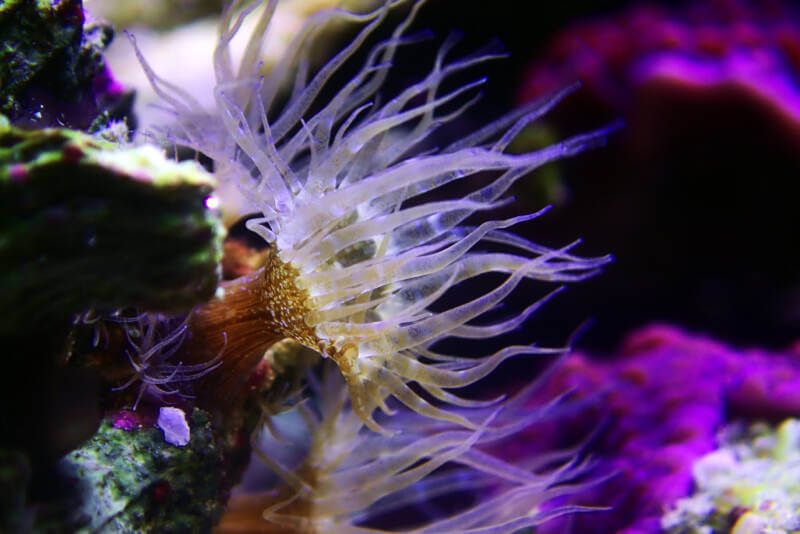
These sea anemones make themselves at home on live rocks and within coral colonies. Then they hitch a ride into your reef and marine tanks, where they stay FOREVER.
Okay, maybe not forever. But if you’ve ever attempted to eradicate this pest species, it feels like forever.
Aiptasia have unique adaptations that allow them to colonize ANYWHERE. It makes them an interesting anemone – but not one most aquarists want around.
And when it comes time to remove Aiptasia from your reef tank, you’re in for an uphill battle.
You’ll find suggestions from the simple to the bizarre – and some have better success rates than others. It’s enough to drive any aquarist crazy.
[toc]
What is Aiptasia?
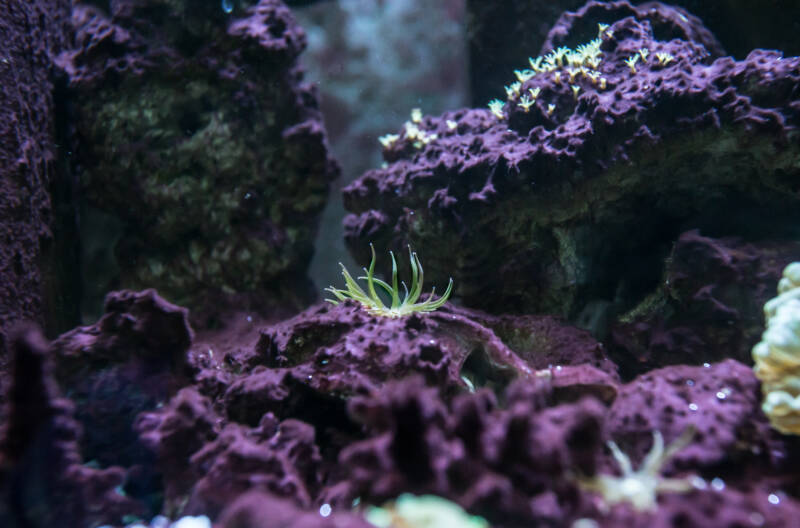
Aiptasia is the genus name for around a dozen species of sea anemones. And ALL of them have a reputation for making pests of themselves in the aquarium industry.
They have such common names as glass, glass rose, rock, and tube anemones.
It’s easy to pick these opportunistic pests out from the crowd. Only about 2 inches (5 cm) high, they look like swaying palm trees in the tank current.
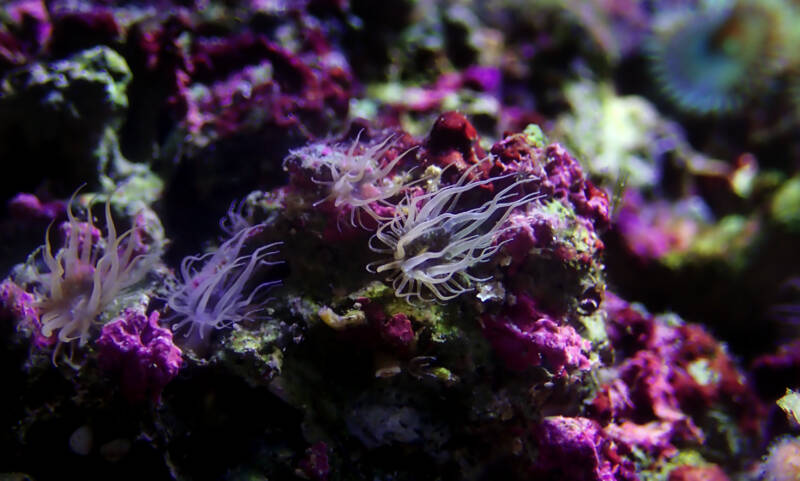
They anchor themselves with a pedal disc from which extends the polyp body. And from the body, you get the tentacles.
Aiptasia belong to the Cnidaria Phylum, which means they come equipped with stinging cells or nematocysts. And the tentacles are COVERED with nematocysts.
They’re also full of helpful zooxanthellae. These algae cells produce a brown color and provide nutrition to the anemone.
What makes Aiptasia bad for tanks?
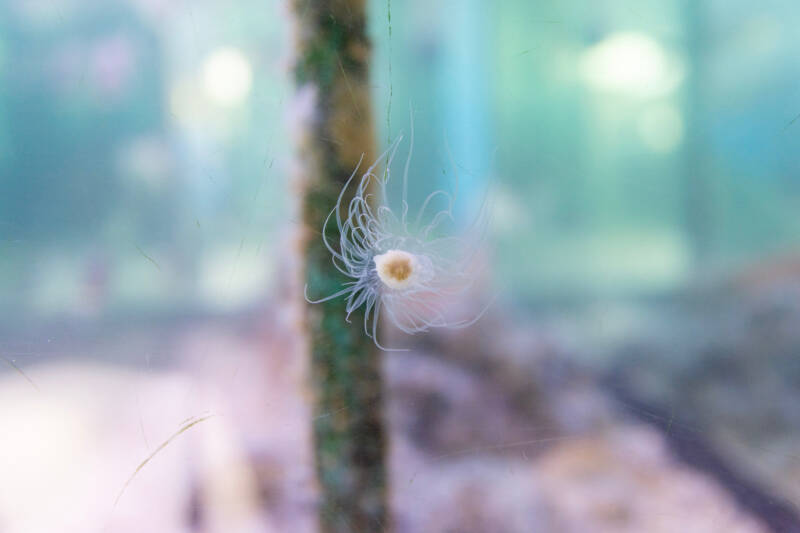
While they won’t win “anemone of the year” in looks, Aiptasia share the same characteristics as other sea anemones. And plenty of aquarists WANT to keep them in their reef tanks as a “water filtration” crew.
So why does Aiptasia get such a bad reputation? There are a couple of reasons.
Nematocyst Nuisances
Tentacles top that annoyance list. Those nematocysts contain a toxin. That isn’t unusual.
What IS strange is the strength. It’s enough to pose a threat to other members of the tank. And not just other anemones, either. Aiptasia sting ANYTHING that comes near them!
The stinging cells act as a defensive mechanism. (Aiptasia ARE a soft invertebrate, and they appear on the menu of other animals) But these anemones also use the nematocysts for offensive purposes.
As they make themselves at home in your tank, they use their stinging cells the way a bully uses their fists.
Whether you have fish, crustaceans, corals, or even mollusks in your aquarium, no one’s safe. Everyone will end up coming within a tentacle’s reach – eventually.
Can Aiptasia kill fish?
Aiptasia feed on plankton they catch from the water column. (In addition to the extra nutrients their zooxanthellae provide)
They’re not large enough to go after most fish in a tank. However, they’re defensive little cnidarians. And when threatened? They lash out. Lucky for most saltwater fish, the toxin found in the nematocyst isn’t strong enough to inflict a killing blow. It WILL irritate, though.
And if the fish encounter a large patch of Aiptasia (a likely occurrence), the irritation could lead to scale damage and infection.
As for small fish, juveniles, or invertebrates? Those tentacles CAN mean harm. Even death is possible, depending on their size.
And, as surprising as it sounds, Tridacna clams aren’t safe. The nematocysts go straight into the mantle of the clam!
Can Aiptasia kill Zoanthids?
While many corals remain stationary, they’re not exactly defenseless.
Both LPS (large polyp stony) and SPS (small polyp stony) corals wage war with one another. They produce their own chemicals, and many species have sweeper tentacles that emerge to defend their territories.
Unfortunately, Aiptasia have no problem “facing down” corals. Their nematocysts produce the same irritation to the polyps that fish experience. And with enough exposure to the toxin, many polyps end up dying.
As if that weren’t bad enough, this pest anemone is RESISTANT to many of the chemicals and stings of other corals.
So even when a coral attempts to defend itself (and its place in the aquarium), the battle fails. Then the Aiptasia runs right over the poor coral.
Can you touch Aiptasia?
Knowing that, you may worry that brushing against one of these sea anemones could be hazardous to YOUR health. And while those tentacles lash out at anything that comes near them, Aiptasia aren’t a threat to humans.
Your skin is too thick for the nematocysts to get through. You may notice a slight irritation, or you may notice nothing at all.
But you don’t have to worry about taking any damage. The stinging cell won’t go through your skin, and the toxin isn’t dangerous to humans.
In reality, though, these pest anemones avoid human interaction as much as possible.
When they sense you coming, they immediately withdraw into their pockets in the live rock. No matter how small the crevice, the odds you’ll reach them are slim.
Hostile Takeover

When you see one Aiptasia clinging to a piece of live rock, expect to find plenty more.
These pest anemones adapt to any environment they find themselves in. And they quickly make themselves right at home. That’s the other major problem for marine tanks.
Within a short period, Aiptasia spread throughout an aquarium. They use their stinging cells to “muscle out” any of the current inhabitants, and they take over the habitable space.
Then they monopolize the food supply. And getting rid of them? That’s a chore.
Why are Aiptasia labeled pests?
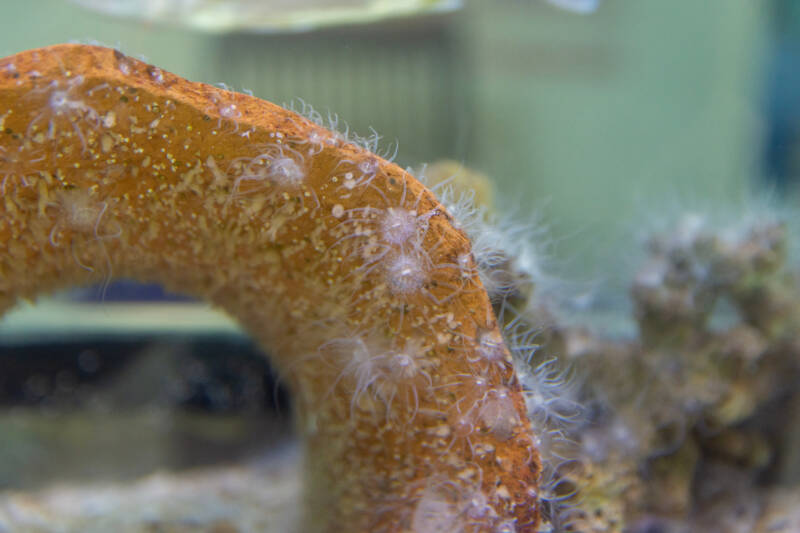
So, these drab-colored anemones aren’t the best thing to find in your tank. But does that make them a pest?
As it turns out, YES. Because what’s the definition of a pest? An intruder that causes problems for the residents and is challenging to remove.
Aiptasia aren’t picky about their diets. They’ll use their tentacles to sweep up anything passing in the water – and that includes pieces of commercial fish food!
With a speed that seems impossible for an invertebrate, they out-compete your tank’s inhabitants for sustenance.
And they’re masters at gaining nutrients. They grab what they can with their tentacles. And, of course, the zooxanthellae pitch in.
They can ABSORB dissolved nutrients directly from the water. Aquarists have stumbled on them, happily thriving in sump pumps!
Not to mention the fact they wage war for space in the tank. As they spread out from their initial stronghold, they “push” everyone out of the way. And they take up more and more space, leaving your reef tank looking like a swaying forest of brown tentacles.
How Do Aiptasia Grow?
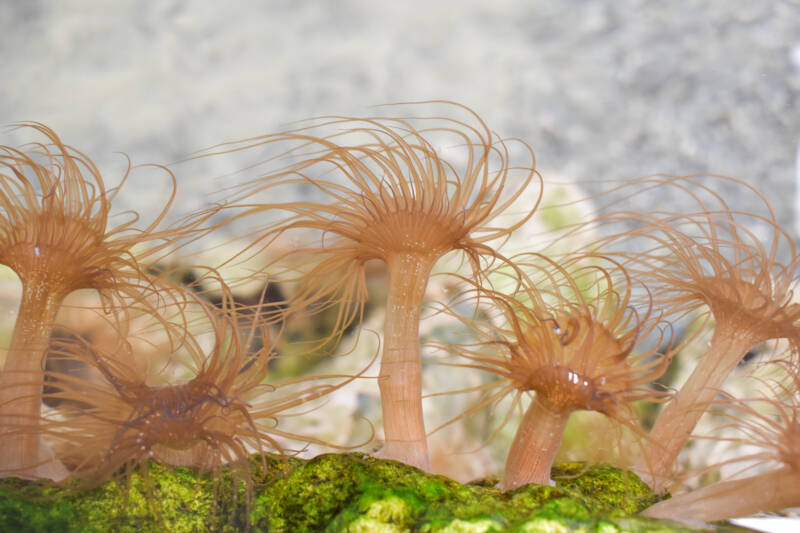
One of the biggest reasons Aiptasia turn into pests is their astounding ability to grow and swarm through a marine tank.
In the blink of an eye, you can go from one tiny “palm tree” to an entire colony. And it takes NOTHING to cause that to happen.
Aiptasia are hermaphrodites. A single anemone carries both sperm and gametes at the same time. But that isn’t the entire story. This particular group of anemones reproduces in two different ways:
- Sexual reproduction
- Asexual reproduction.
And it’s the asexual reproduction that gets aquarists in the most trouble. As the anemones move throughout the tank, they undergo pedal laceration. Small cells of the disc break off. Then they drift around the tank, settle, and grow a whole new Aiptasia.
Even the TINIEST piece of the anemone can spawn a new organism. And that’s how they turn into genuine pests.
Aquarists think they’re eradicating them when they may be causing more problems. And if fish brush against one and break off cells? You got it – more anemones.
How Do You Get Rid of Aiptasia?
Contemplating a hostile takeover by this invertebrate sends shivers down the spine of any aquarist.
And as soon as one Aiptasia appears, you know more won’t be far behind. The second they start feeding and moving, more appear.
But you can’t simply pluck them out of place. They sense the approach of danger. They’ll withdraw their tentacles and sink into the live rock they hitched a ride with. And your odds of getting them out? Not good.
There are plenty of Aiptasia removal options available, but they come with risks. If you don’t successfully eliminate ALL of the anemones, it WILL repopulate.
And any time you work with chemicals, you run a risk of changing the water conditions in your tank. Before you decide to draw the battle lines, read through any instructions carefully.
After you start the pest control process, monitor your corals for signs of stress. This goes double if you use any kind of chemical. You may need to halt and perform a water change.
Natural Methods for Removing Aiptasia
Aquarists spend money and time cultivating their corals and anemones (the ones that AREN’T pests). As such, they don’t like risking their reef tanks with risky chemical treatments.
Instead, they use natural pest removal options when facing down an infestation.
This is something you can consider, but you’ll need to keep a few things in mind. Many of the species that eat Aiptasia also feed on coral polyps or feather dusters.
They may put your other reef residents at risk – when they decide to eat the pests in the first place (it’s not a guarantee).
And many of these natural pest control species are challenging to manage mainly because they are so specific in their diet.
You’ll need to come up with plans once the pest anemones are eliminated. (Consider passing them on to another aquarist)
Fish That Eat Aiptasia
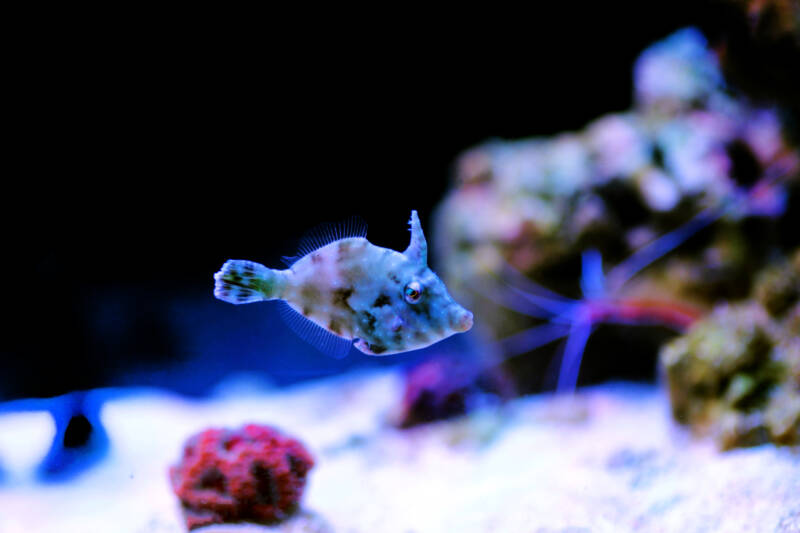
Some of the best options to eliminate Aiptasia show up among the fish world. And they’re considered reef-safe, for the most part.
You’ll need to watch them around some of your other anemones and coral polyps, especially when the pests are gone.
Everyone has their favorite fish species to turn to, and some work out better for removing those brown palm trees than others. But the top fish species for removing pest anemones include:
- Bristletail filefish (Acreichthys tomentosus)
- Copperband butterflyfish (Chelmon rostratus)
- Filefish / Bristletail Filefish (Acreichthys tomentosus)
- Pufferfish from the Canthigastrinae subfamily.
Invertebrates That Eat Aiptasia
Ensuring you have the proper tank size to house fish may cause problems.
For instance, filefish can’t go into tanks smaller than 30 gallons (114 l). And some puffers grow exceptionally large (especially if fed on a large colony of pest anemones).
In that case, you may want to turn to invertebrates for your Aiptasia control program.
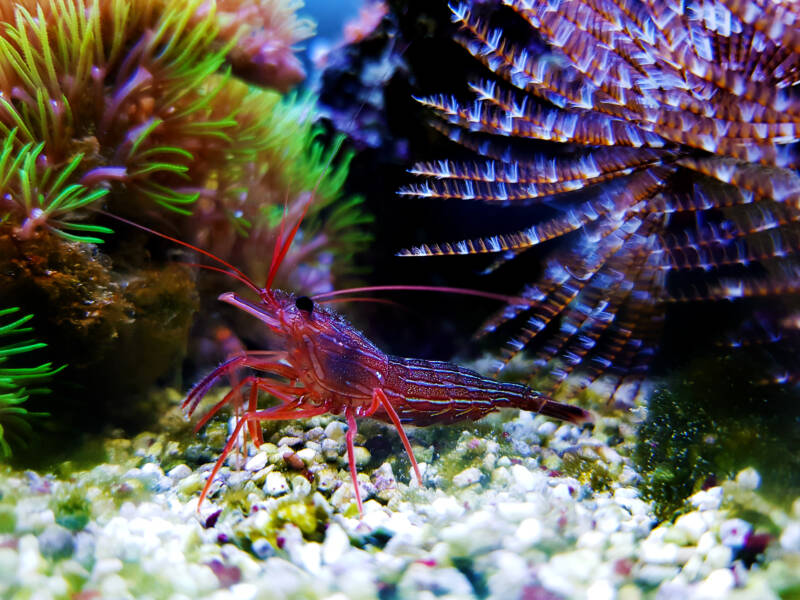
These hardy little reef-dwellers are adept at clearing out the anemones without requiring a lot of room in your aquarium:
- Peppermint shrimp (Lysmata wurdemanni)
- Hermit crabs (Dardanus megistos)
- Sea slugs from the Berghia genera.
However, you can get into trouble when you start shopping for your natural pest control.
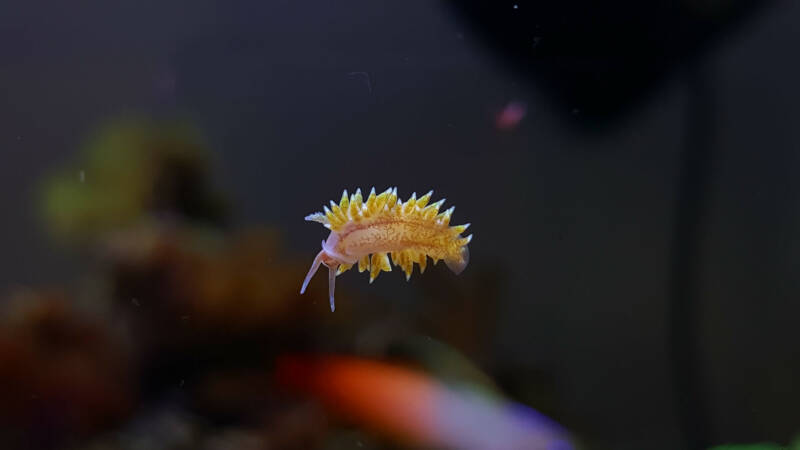
Camelback shrimp (Rhynchocinetes uritai) look similar to peppermint shrimp, and they sometimes get mislabel. They WON’T touch Aiptasia, but they WILL eat coral polyps!
Berghia sea slugs ONLY eat the pest anemones. Once they run out of their food source, they start to starve.
This means you need a plan for how to keep them alive. And that may mean introducing new Aiptasia to your pest-free tank.
Household Remedies
If you don’t have to splurge on costly gadgets or expensive chemicals, why do so?
Plenty of people use ordinary household options to handle their Aiptasia breakouts. All you need to start are the following:
- Gloves
- Syringe
- Hypodermic needle.
Boiling Water
If you’d rather skip playing around with needles, you can lift your live rock – complete with the anemone invader – and place it into boiling water. While Aiptasia are hardy little anemones, they WON’T survive that process.
Unfortunately, neither will anything else on the live rock. It’s the compromise that comes with choosing to boil your pest anemones.
And if you have a severe infestation? This may get tricky, especially if you have fish or invertebrates that depend on the live rock for food.
Lemon Juice
While acidic, lemon juice isn’t as dangerous as other compounds, you might use in an aquarium.
But the amount of harm it poses will depend on how steady your hand is, how slow you move, and how large a colony of Aiptasia you’re dealing with.
You need to inject approximately 0.5 mL of lemon juice into each anemone. And that needle needs to reach into the disc.
If you only go into the “mouth,” the Aiptasia will “spit” the juice out into the water. You’ll need to work as methodically as possible to prevent retraction.
Home Remedies to AVOID
Some people suggest using bleach or vinegar in similar methods. And bleach WILL work on live rock the same way boiling water will.
But there are nooks and crannies EVERYWHERE. And trying to make sure you rinse everything so the bleach doesn’t enter your tank? Impossible.
Vinegar presents a similar problem. You DON’T want vinegar in a saltwater tank. You’ll cause your fish and corals harm. Not to mention the havoc you’ll wreak on the water conditions.
As it’s so difficult to hit the anemones with a needle in the first place, you’re better off skipping it.
Chemical Solutions
No one likes using chemicals in their reef tank. You spent how much time and money achieving that beauty?
But when you’re coping with an invasion of Aiptasia, you may find yourself desperate for a solution. Especially with a massive colony.
If you use chemicals, always read the instructions first to make sure you’re diluting the mixture appropriately.
And ALWAYS wear safety gear. When you finish, check your water for changes, particularly the pH level. You don’t want to accidentally stress – or even kill – your corals.
Calcium Hydroxide (Kalkwasser)
One of the most popular chemical solutions for Aiptasia is calcium hydroxide, also known as Kalkwasser. It’s limewater that increases the pH in the anemone, along the same lines as lemon juice (but on a much more powerful scale).
You need to use a needle and syringe, and the solution has to go directly into the anemone for things to work correctly.
If you don’t see the colony dying off, you may have an incorrect solution. Or you may be missing with the needle.
Hydrogen Peroxide
Unlike other chemical solutions, you don’t need to dilute hydrogen peroxide. Of course, it’s also much more dangerous to play around with. It WILL kill the pest anemones when injected properly. And it doesn’t take long to do so.
But if any of the peroxide finds its way into your water? You have a real problem.
It’s not the best choice of chemical to reach for unless you’re feeling desperate and can’t locate any other options.
Sodium Hydroxide
When you use sodium hydroxide to fight Aiptasia, your success rate goes up a little higher.
Even if you miss your injection, you usually get results of about 50:50. It comes down to mixing the solution right and then working slowly.
However, this is another dangerous chemical. The proper solution? It’s strong enough to BURN the skin off YOU.
You’ll have to ask yourself whether you honestly feel the risk is worth taking. And, again, don’t let any of it get loose in the aquarium.
Other Aiptasia Removal Methods
With Aiptasia making such pests of themselves in saltwater aquariums, plenty of elimination methods have cropped up over the years.
You can find commercial products that help you tackle the anemones – without harming your tank in the process.
Working with a reef-safe product is in your best interest if you want to prevent damage to your delicate corals. Some of the top options out there include:
Or you can go high-tech with your pest anemones. The Majano Wand works with electricity to “melt” the anemone.
It’s expensive, and you’ll need plenty of time if you have a large infestation. Not to mention you’ll need the patience to make sure the Aiptasia doesn’t retract out of reach.
And if you’re desperate, you can find lasers that do the job. But these require LOTS of finesse and care.
Water distorts vision, and you may end up missing your target. Plus, they only work for five minutes at a time. And the expense? It’s ridiculous for pest removal.
Can Aiptasia Survive Out of Water?
Of course, if you’d rather skip the hassle, you may decide to go LOW-TECH.
Why not remove the live rock and leave it out of the tank altogether? Sea anemones are aquatic species, and they require water to survive, right?
That rule holds, even for a pest like Aiptasia. However, that adaptive system of theirs kicks in in this situation, too.
They often LEAVE water to travel to new colonizing places. And aquarists transport them into aquariums as shriveled up hitchhikers in live rock.
Aiptasia can survive outside of water for several days. If you want to use this as your removal method, prepare to wait them out.
And, similar to boiling water, you’ll end up suffocating all of the other helpful species attached to the rock, as well.
The Dreaded Saltwater Aquarium Pest
Hard as it is to believe, some aquarists make their peace with Aiptasia.
The anemones aren’t the most attractive, but they do add movement to a tank. And as long as they don’t grow out of control, they remain a part of the aquarium’s ecosystem.
But when this pest invertebrate grows out of control and overtakes your corals? It’s time to consider plans for removal.
It’s a task that requires careful thought and planning. Because if even the tiniest piece remains, the anemone will happily regenerate and continue to spread.
Have you put up with Aiptasia in your tank? What removal methods have worked for you?
Or do you allow the anemone to stay in the aquarium?
Share your stories and questions with us here!
